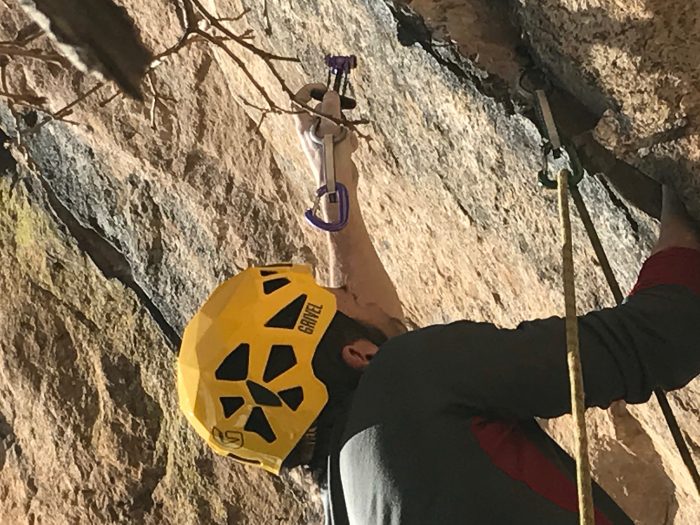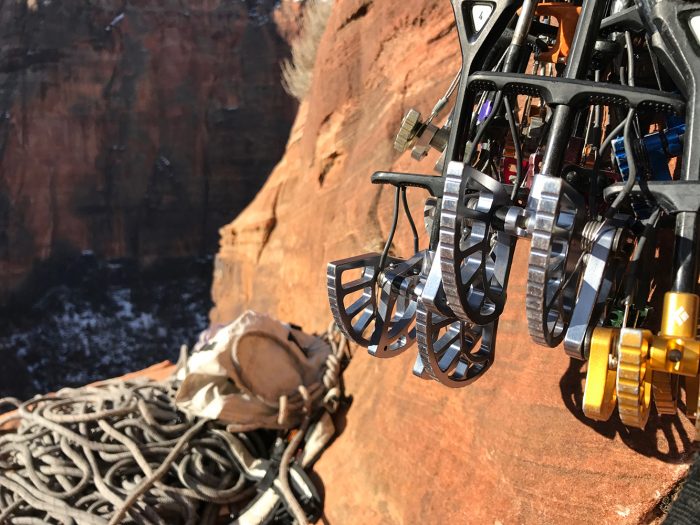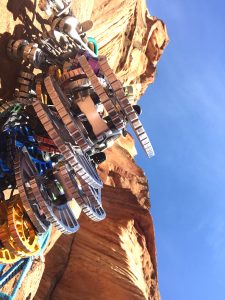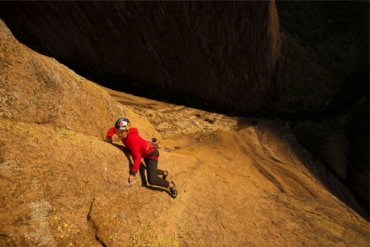Black Diamond’s Camalots are a staple of climbing protection. Released last year, the Camalot Ultralight is a high-tech upgrade for the light and fast climber’s rack.
In two decades of climbing, I’ve never coveted a piece of gear as much as the Camalot Ultralight. A standard component on a climbers’ gear rack, sling-loaded camming devices (SLCDs) are placed in cracks to protect lead climbers as they ascend rock faces. Climbers carry many of them on long routes to stay safe, so light weight is key to moving faster and more efficiently.

Enter the Camalot Ultralight. Various camming devices on the market actually match the weight and quality of this unit (Metolius’ Master Cams and Totem Cams), but they don’t allow the extended range of placements offered by the Ultralight’s double axle.
Black Diamond says Camalot Ultralights, released in 2016, represent the most significant advancement in technology for climbers since the company introduced dual stem “cams” in the 1980s.
I can’t argue. Ridiculously light, BD redesigned the lobes and triggers and replaced much of the device’s steel and nylon with the ultra-strong super fiber Dyneema.
The result is a 25% weight reduction versus the standard Camalot.
Black Diamond Camalot Ultralight Review
I tested these cams over three months, while solo aid climbing for two days in Zion National Park, cragging in Colorado, and putting up first-ascent routes at a sandy undeveloped cliff in Southern Utah.
Tried and true, all versions of the Camalot (the Ultralight is the fourth version) have the double axle that increases the range of placements for an individual units when compared to other camming devices.
It also means the cams “hold” better in shallower cracks and are less likely to “walk” (i.e. wiggle deeper into a crack). Plus, the single stem allows for placement in both horizontal and vertical cracks, and the thumb loop ensures smooth trigger action.
In my opinion, the light weight of the Camalot Ultralights also adds to how well this gear handles. I noticed a significant difference after a 13-hour day followed by a six-hour day in Zion.
My swollen and abraded fingers appreciated the ease with which I could pick the pieces off my gear sling and pull the trigger to place in the cracks.
Ultralight Cams
The company claims the Camalot Ultralights are ideal “when weight really matters.” I think they’re ideal all the time. The older I get (43), the lighter I travel, whether I’m cragging or big wall or alpine climbing.
A set of Camalot Ultralights in the size range of .4 to #4 weighs 25 percent less than the previous version of the cam—the C4.
BD replaced the C4’s nylon webbing with a slim 14mm Dyneema tape sling and the C4’s steel stem cable with a continuously looped Dyneema core stem (i.e. really strong). Also, the Ultralight has lower-profile, sculpted lobes and smaller diameter trigger wires.
Strength
Does the light weight compromise the strength? Handling an Ultralight Camalot for the first time, I wondered about this. And there is, in fact, a 2kN reduction in overall strength. However, that’s fairly insignificant; at 8-12kN, these SLCDs can still take between 1800-2700 lbs. of force.
Durability
Will the Ultralights last as long? Avid aid climbers or people who beat their gear to hell might wear out the Camalot Ultralight’s lower-profile lobes a bit faster than other cams. And, as with all cams, the slings will eventually need to be replaced.
BD did some “non-scientific” studies and found that nylon outperformed Dyneema in ultimate strength after “similar exposure to the elements, including abrasion.” However, Dyneema is UV resistant on its own, stronger than steel by 15X on a weight by weight ratio and can withstand extreme weather conditions. And it’s significantly lighter. So I still prefer Dyneema.
The Ultralight’s stem has added protection in its UV-proof plastic sheath. Unless you break through the plastic, the Dyneema inside will last a long time. As these are less than a year old, it is still unclear how the Dyneema stem will compare to steel in terms of longevity.
Except for the price tag, I have no criticism of Black Diamond’s Camalot Ultralights. They are badass.
Camalot Ultralight .4, .5, .75, #1, #2, #3 and #4
Available Online: $89.95-$129.95 at www.blackdiamondequipment.com
Who’s It For: Rock, ice, and alpine climbers counting every gram.
Very cool: The Camalot Ultralights are made in the USA, right in Salt Lake City where Black Diamond is based.
Camalot Ultralight Weights
- [.4] 61 g (2.15.oz)
- [.5] 74 g (2.61 oz)
- [.75] 89 g (3.14 oz)
- [#1] 101 g (3.56 oz)
- [#2] 126 g (4.44 oz)
- [#3] 167 g (5.89 oz)
- [#4] 225 g (7.94 oz)
Camalot Ultralight Strength
- [.4] 8 kN (1798 lbf)
- [.5] 10 kN (2248 lbf)
- [.75] 10 kN (2698 lbf)
- [#1] 12 kN (2698 lbf)
- [#2] 12 kN (2698 lbf)
- [#3] 12 kN (2698 lbf)
- [#4] 12 kN (2698 lbf)
Awesome! Super light, yet still durable and one of the most highly functional and easy-to-use sling loaded camming devices on the market.
Flaw: These are some of the most expensive cams on the market.
First Impressions: Ridiculously light, super smooth trigger action.
Who Should Buy It: Any rock, ice, or alpine climber who wants to carry less weight.











